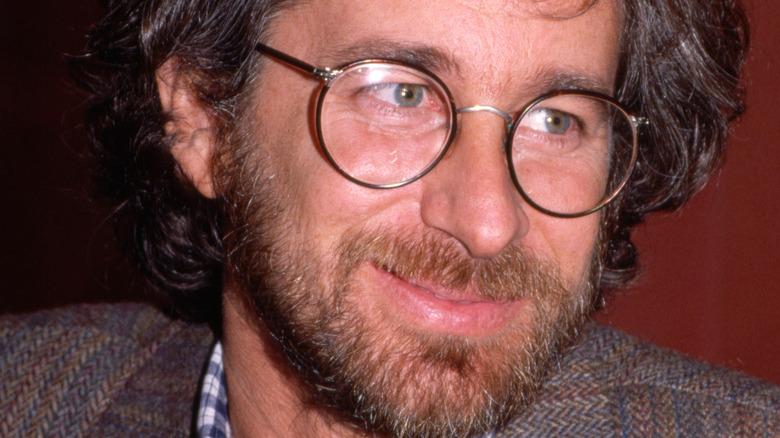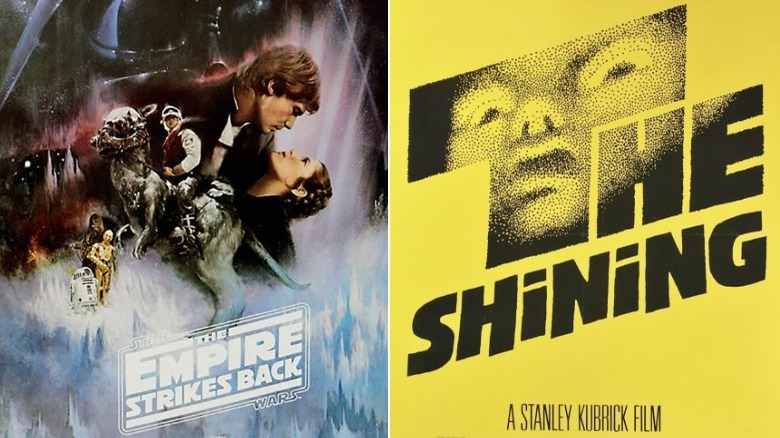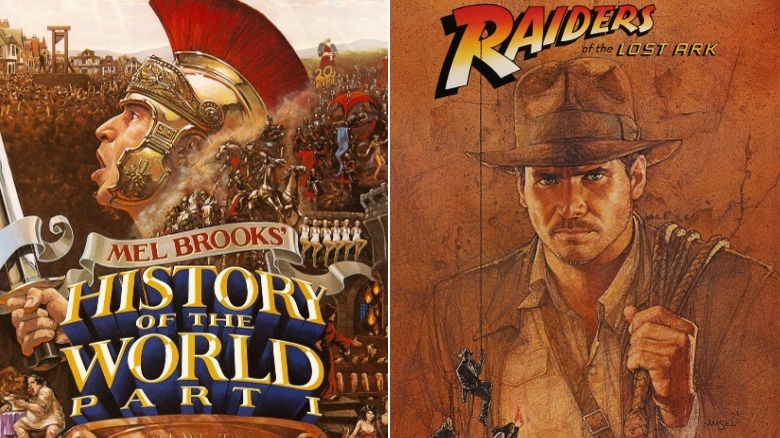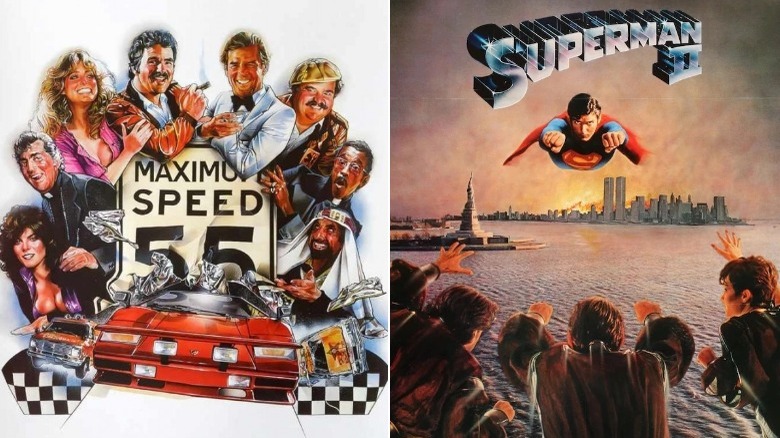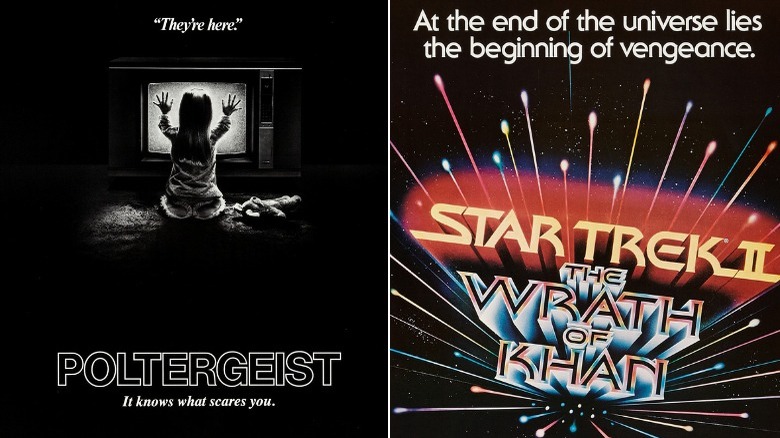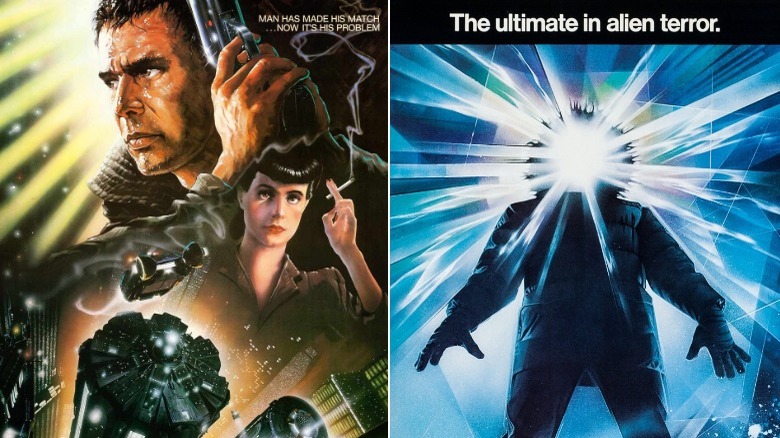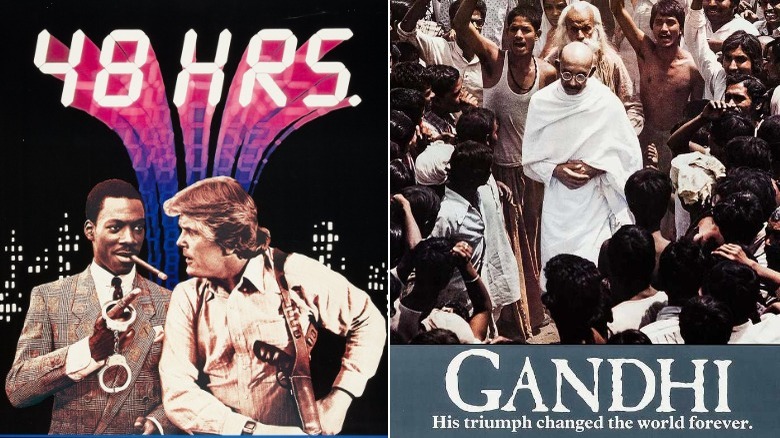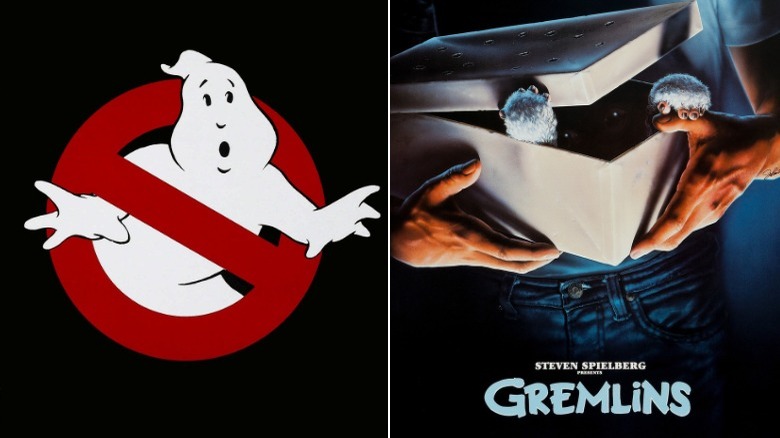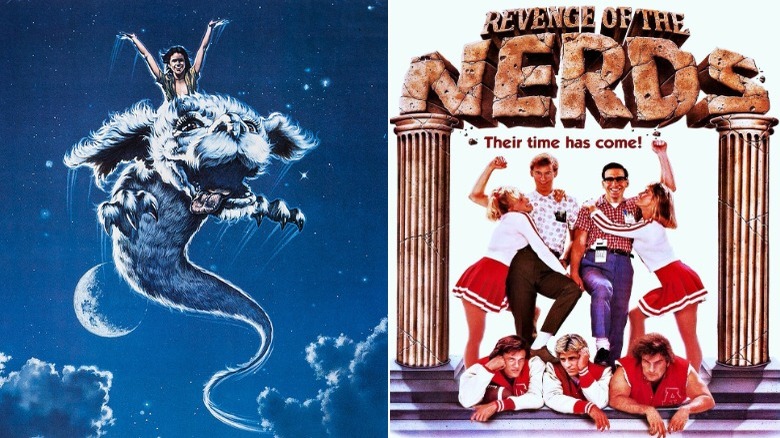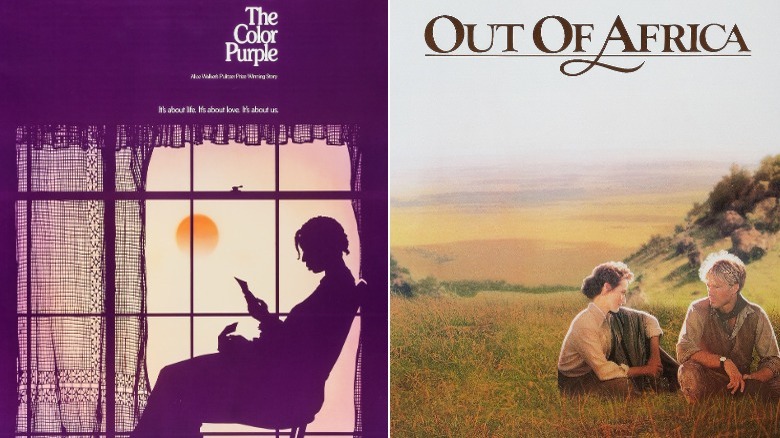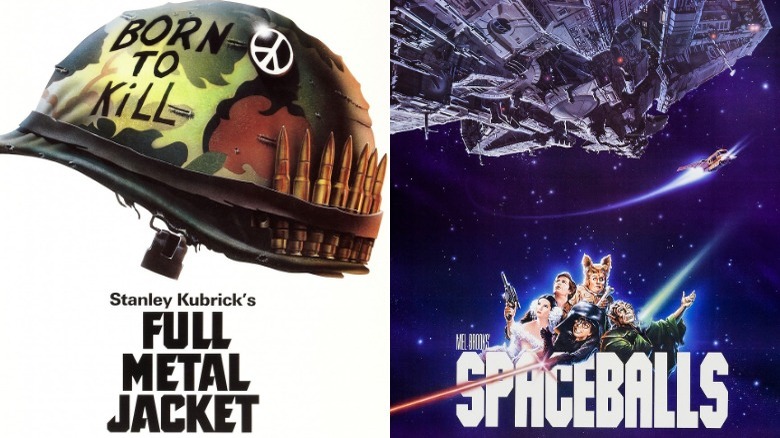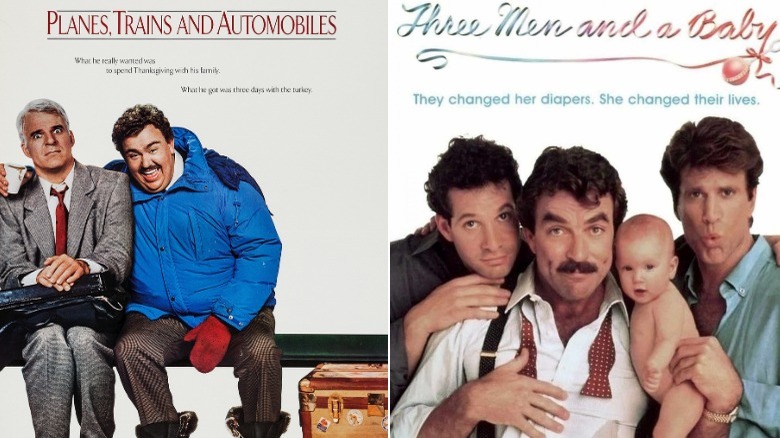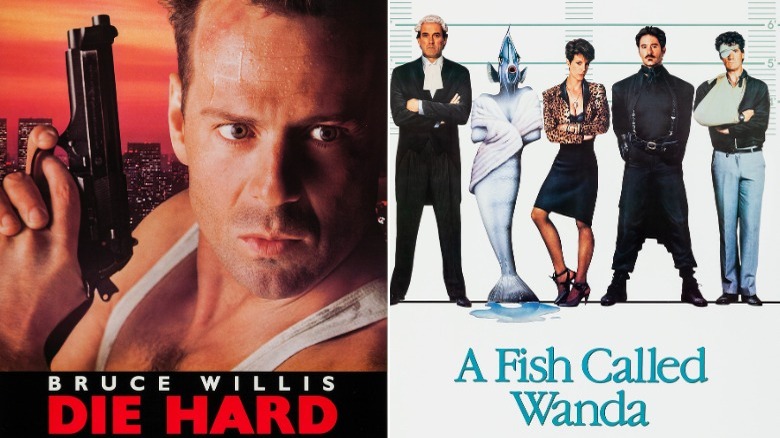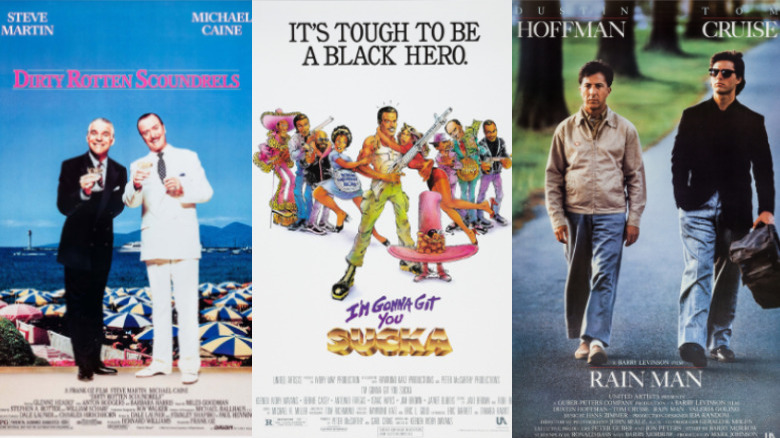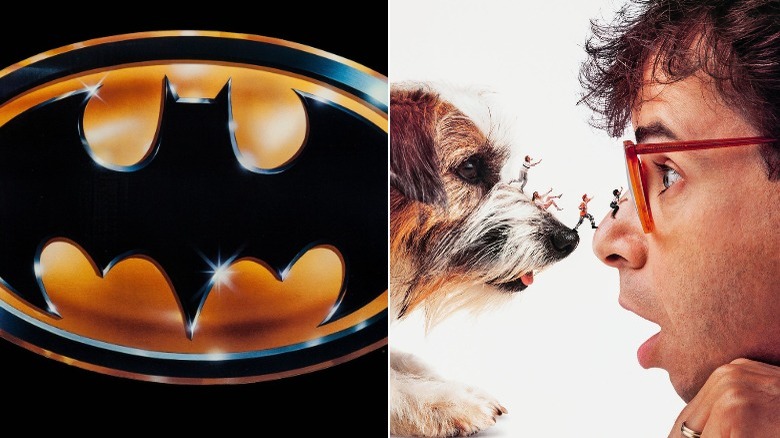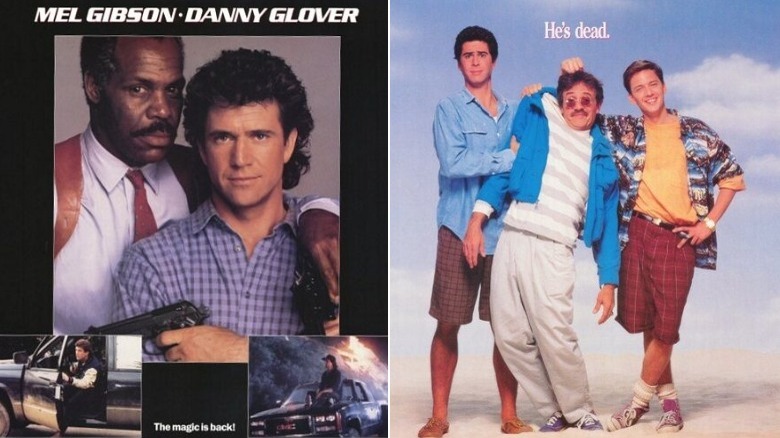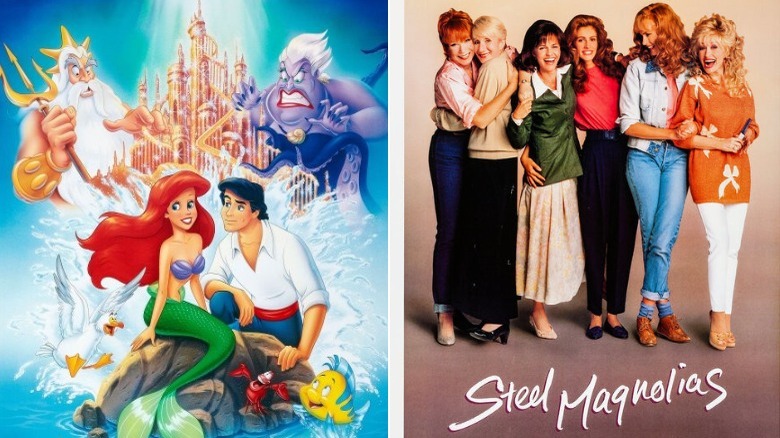Classic 80s Movies That Actually Opened The Same Week
The 1980s were a gift to movie lovers — perhaps one of the last great decades Hollywood had to offer, with a treasure trove of classic movies that came to life over ten glorious years. In fact, there were so many classic films jammed packed in that decade that it was inevitable that some of them had to open in theaters on the same weekend as another. The box office battles might not have seemed epic at the time, but in hindsight, they look like an epoch of awesomeness on a cinematic pedestal.
There was such a glut of classic movies to choose from, in fact, that frequently theater owners had to decide which instant-classic they were going to kick out to make way for another. Such quandaries led to the expansion of more screens, giving rise to multiplexes of the 1990s.
While some of these '80s battles in theaters for the eyes, attention and money of audiences have become the stuff of legend — like when "Ghostbusters" crossed streams with "Gremlins" — others are not. With that in mind, let's revisit the best of these cinematic smackdowns, along with the common links (beyond a release date) that have linked these films together, now and forever.
The Empire Strikes Back and The Shining (May 1980)
Ticket buyers in New York and Los Angeles were given perhaps the ultimate can't go wrong choice when the summer movie season kicked into high gear with Jack Torrance and Darth Vader facing off to see who was the worst cinematic father. Both Stanley Kubrick's "The Shining" and Irvin Kershner's (taking the reins from George Lucas) "The Empire Strikes Back" were filmed at EMI studios at the same time, even sharing some crewmembers, and were delivered in limited release, in 10 and 126 theaters respectively, both paling in comparison to the third new opener that week: "The Gong Show Movie."
While people slept in line to see the "Star Wars" sequel, the movie that screamed bloody "REᗡЯUM" actually had a better per screen average of more than $62,000 per theater. The "Star Wars" saga was influenced from Kubrick's "2001: A Space Odyssey," and while Kubrick was a fan of Lucas, he questioned the director's career choices, saying "If I made as much money as George Lucas, I would not decide to become a studio mogul. I cannot understand why he doesn't want to direct films anymore, because 'American Graffiti' and even 'Star Wars' were very good."
Clash of the Titans / History of the World Part I / Raiders of the Lost Ark (June 1981)
History lovers had a cornucopia filled with ambrosia to feast on in theaters in mid-June of 1981, as Greek Mythology squared off against the journey of mankind and a fedora donning, whip cracking archeologist hoping to keep Nazis at bay from holy antiquities. When "Clash of The Titans," "History of the World Part 1," and "Raiders of the Lost Ark" incredibly all played over a single weekend, one could have experienced the sights of Medusa come to life (thanks to magic of Ray Harryhausen), the presentation of the 15 Commandments, and the essence of God melt faces.
Critic Lou Lumenick, fresh on the job when tackling all three, later lamented calling "Raiders" "a very entertaining junk-food movie that will be forgotten." Audiences cheered on Indiana Jones the most that weekend, but Jason & the Argonauts and Mel Brooks in many costumes each did respectable business. Brooks never got to spoof Professor Jones (a role Harrison Ford booked, but "Titan" Harry Hamlin didn't, with "History" and "Ark" sharing casting directors), but later received George Lucas' blessing on "Spaceballs," as long as there was no merchandising.
In the time since, "Clash of the Titans" got a (perhaps even campier) remake in 2010, Indiana Jones is embarking on his fifth big screen adventure; fans are still waiting, however, for "History of the World Part 2."
Cannonball Run / Superman II (June 1981)
If one had a need for cinematic speed, by land or by air, and you required the talents of Valerie Perrine, then June 19, 1981 was the day you circled in your calendar, as "Superman II" and "Cannonball Run" began to run their courses on that very day. Clark Kent's second adventure where he was a more mortal Man of Steel, featuring Perrine again as the much yelled at Eve Teschmacher, had to duke it out for eyeballs versus a Burt Reynolds/Dom DeLuise vehicle (literally) about a star-studded cross-country car race, which featured Perrine as a saucy police officer.
While the allure of watching James Bond (Roger Moore) and Jackie Chan sit in car seats did put butts in actual theater seats, few could resist kneeling before Zod, making "Superman II" not only the weekend champ, but later the biggest winner of all in 1981 movies.
Before Christopher Reeve landed the "Superman" gig, Burt Reynolds was initially considered for the first film. In fact, when the husband-wife writing team of David and Leslie Newman were re-working Mario Puzo's screenplay of the original film, they did so for Reynolds.
"When we wrote, we always heard Burt Reynolds reading those lines in our minds," said Leslie, with David adding: "What Reynolds gave us was an attitude, a sense of humor." In some alternate reality, perhaps Christopher Reeve ended up driving across America with Dom DeLuise.
Poltergeist / Star Trek II: the Wrath of Khan (June 1982)
If you were a hit '80s movie with dazzling visual effects, your credit roll contained a lot of artists' names who worked at George Lucas' post-production house: ILM , many of the whom employed their talents on "Poltergeist" and "Star Trek II: The Wrath of Khan." Both films opened wide against a forgotten Sidney Poitier-directed comedy called "Hanky Panky," which is trivially known as the movie where Gene Wilder fell in love with Gilda Radner.
"Wrath of Khan" had a built-in audience (and a throwback chesty badguy), but had more to prove after the first "Motion Picture" was so longwinded that it felt more like a still picture. "Poltergeist" was a PG-"friendly" haunted house horror movie that was either directed by Tobe Hopper or producer Steven Spielberg, depending on who you ask.
By the end of that first weekend, it wasn't only Captain Kirk who was screaming Khan's name, as the fans helped to make it the largest opener in box office history. It was directed by Nicholas Meyer, who had never seen the series or the first movie, nor was a giant fan of special effects.
"If somebody said to me, 'You can take a pill and you'll know as much about camera as George Lucas or Steven Spielberg, but you'll lose whatever concern about human beings that you have,'" Meyer told the New York Times, "I don't think I would take the pill."
Blade Runner / The Thing (June 1982)
One of the more famous same-day release pairings was Ridley Scott's dystopian "Blade Runner" and John Carpenter's remake of "The Thing." Both sci-fi movies had beautiful posters that invited potential ticket buyers to buy into the mystery each was selling — John Alvin's film noirish one where Harrison Ford loomed over a dark futuristic city, and Drew Struzan's iconic icy treatment that he came up with in one night with no reference material with which to work.
It's hard to believe that neither modern classic was a box office smash upon arrival (both were considered bombs and couldn't even top $28 million in their full runs), but it didn't help that at the time America's heart was too busy growing large for an alien creature's glowing heart; "E.T. the Extra-Terrestrial," which opened at number one the week prior, would hold onto that spot for 16 weeks.
Scott was unhappy with the studio's version of "Blade Runner" and has since tinkered with it several times. Ennio Morricone's score to "The Thing" was nominated for a Razzie Award, and 34 years later, he revived three unused tracks from that score and won his first competitive Oscar for Quentin Tarantino's "The Hateful Eight."
While Kurt Russell has yet to work with Ridley Scott in any one film, he did star in Paul W.S. Anderson's 1998 sci-fier "Soldier," which some consider an unofficial sequel to "Blade Runner." Both films were written by David Webb Peoples, and contain similar themes of man vs. machine.
48 Hrs / Airplane II: The Sequel / Gandhi / Sophie's Choice / The Toy / The Verdict (December 1982)
Christmas came early for movie lovers on December 10th, 1982, when three popcorn flicks opened wide, and three other Oscar hopefuls were released in limited fashion. Paramount Pictures dropped two comedy gems in theaters — the punny "Airplane II: The Sequel," and the Nick Nolte/Eddie Murphy buddy cop/con actioner "48 Hrs," while Columbia Pictures pitched in the high-brow "Gandhi" biopic, and the low-brow Richard Pryor vehicle "The Toy," and the other two more sobering offers were "Sophie's Choice" and the Sidney Lumet/Paul Newman classic "The Verdict."
"The Toy" won the weekend (although the film's storyline hasn't exactly aged well), "48 Hrs" ultimately amassed the most in its total box office run ($78.8 million), and between the three prestige films, they garnered 21 Academy Award nominations, netted 9 wins, including Meryl Streep's first Best Actress win for her "Sophie's" work, and Best Actor (Ben Kingsley), Director (Richard Attenborough) and Picture for the epic about the Indian icon affectionately nicknamed Bapu.
"48 Hrs" eventually got a sequel eight years later in "Another 48 Hrs," and although "Airplane III" was teased at the end of number "II," Star Robert Hays kept it from taking off. While Attenborough seemed to create a complete picture on the life and times of Mahatma Gandhi, that didn't stop the irreverently fun "Weird Al" Yankovic movie "UHF" from giving him new life as "no more Mr. passive resistance" in a trailer for "Gandhi II."
Ghostbusters / Gremlins (June 1984)
Perhaps the biggest '80s same release showdown came about on June 8, 1984 as two classics conjured up similarly spooky prospects. In one corner, you had Bill Murray, Dan Aykroyd and Harold Ramis as "Ghosbusters" trying to prevent The Big Apple from being slimed, and in the other, Zach Galligan and Phoebe Cates were making cute and trying to save Kingston Falls from a multiplying set of ugly "Gremlins."
While the cuddly Gizmo-ed trailer for Joe Dante's "Gremlins" misled tickets buyers and ended up scaring them, the Steven Spielberg-produced film did scare up quite a lot of business, but fell about a million short of Ivan Reitman's marshmallow exploding "Ghostbusters" (poor "Beat Street," the hip-hoppy week's other new entry, had to settle for 5th place). For the next six weeks at the theaters, audiences weren't afraid of no "Ghostbusters" and "Gremlins" as they cemented their respective status as continuous first and second place finishers.
The battle spilled over into toy stores and supermarkets as well, but Dante wasn't buying any of it. He told the Los Angeles Times, "It seems like a perversion of entertainment. You work hard to make a movie and you expect it to stand on its own as a movie. You don't see it as a vehicle concocted to sell toys and cereals."
A box office rematch for the sequels could have happened, but "Ghostbusters II" couldn't wait around for "Gremlins 2: The New Batch" to hatch, and opened in theaters 364 days in advance of it.
The NeverEnding Story / Revenge of the Nerds (July 1984)
Eddie Murphy comedies were all the rage in the 1980s, and even though his "Best Defense" knocked "Gremlins" from its number two spot in the 29th weekend of 1984, it's not the kind of movie people rush to defend these days. Luckily for those seeking something a little bit more fanciful that same July, there were two alternatives — one which took flight for those young at heart, and the other that saw horny Davids topple jockular Goliaths.
On the surface, "The NeverEnding Story" and "Revenge of the Nerds" seem to have little in common. Both, however, featured bullied protagonists on an incredible journey to prove their doubters wrong, including themselves. Audiences saw something of themselves in Bastain flying Falkor and trying to save Fantasia from The Nothing or in the dorky brothers of Lambda Lambda Lambda who out fraternized the Alpha Betas of Adams College. As the years have past, viewers are still having trouble getting that Limahl theme out of their head, or trying to break out all the moves in that nerd talent show rap.
Both spawned franchises that never seemed to end. "The NeverEnding Story" went full trilogy, while "Revenge of the Nerds" begat two cinematic sequel yukfests, a made for TV movie, an almost-remake, and even an unaired TV pilot.
The Color Purple / Out of Africa (December 1985)
As 1985 was drawing to a close, "Rocky IV" was technically knocking out all holiday competition in the ring. This included "The Jewel of the Nile" and "Spies Like Us," as well as Wolfgang Peterson's "Enemy Mine" and Terry Gilliam's "Brazil" (in one lonely theater), and two films based on novels by female writers: Alice Walker's "The Color Purple" by Steven Spielberg and Karen Blixen's "Out of Africa" by Sydney Pollock.
The release date was only the first link that would connect these prestige projects, respectively starring Whoopi Goldberg/Oprah Winfrey and Robert Redford/Meryl Streep, and parallels were constantly being made, including running a single headline to summarize Los Angeles Times critic Shelia Benson's review of both: "Two Women of Substance In Unlikely Places."
The competition between "The Color Purple" and "Out of Africa" spilled into 1986, when the Academy Award nominations were announced and both films were tied with 11 nominations each (but oddly no directing nod for Spielberg). "Out of Africa" ended up triumphing on the big night with 7 total statuettes, including best picture and director, while "The Color Purple" had nothing to show for their beautiful chromatic efforts.
There was no actual rivalry between the two directors. Spielberg wanted Pollack to direct "Schindler's List," counting the director's "Tootsie" as one of his top 20 favorite movies.
Dragnet / Full Metal Jacket / Spaceballs (June 1987)
The appearance of a Stanley Kubrick film in theaters had become a rare sight some seven years after his "Shining" faced off against "The Empire Strikes Back." Kubrick's follow-up work, "Full Metal Jacket" landed in 215 theaters, and got combative against a wide released Mel Brooks "Star Wars" spoof and another about the beloved '50s/'60s Jack Webb TV series "Dragnet."
Tom Hanks and John Candy shared the silver screen with 1983's "Splash" and 1985's "Volunteers," but 1987 would find each of them heading separate ways, as they competed for the same pool of funny bones to tickle. While a furry Candy as Barf the mog and company whipped up quite the comedic fury with "Spaceballs," it was no match that opening weekend for "just the facts" of Hanks as the un-straight man Pep Streebek to Dan Akyroyd's anachronistic Sgt. Joe Friday. Both films were able to hold onto the top two spots for an additional week, fending off the impressive new coming duo of "Innerspace" and "Adventures in Babysitting."
Two weeks after release, "Full Metal Jacket" more than tripled its theater count and jumped to the second spot, slightly trailing that week's new entry, "Revenge of the Nerds II: Nerds in Paradise." Kubrick was mystified by how Ridley Scott pulled off the trick of making a creature burst from John Hurt's chest in "Alien." No word on what he thought of the same scene reprised for laughs in "Spaceballs."
Planes, Trains and Automobiles / Three Men and a Baby (November 1987)
Thanksgiving weekend 1987 had two schmaltzy sweet movies competing, featuring five stalwart talents of the time: Tom Selleck, Ted Danson, Steven Guttenberg, Steve Martin and John Candy. In fact, the posters for both John Hughes' "Planes, Trains and Automobiles" and Leonard Nimoy's (yes, that Leonard Nimoy) "Three Men and a Baby" practically begged audiences to throw their arms around them.
"Planes, Trains and Automobiles" sometimes made for stressful watching, but the buddy dramedy still brought the laughs. "Three Men and A Baby" (and a boy ghost?) was a bit kinder, more gentler, and turned The Spaniels hit song "Goodnite, Sweetheart, Goodnite" into a modern day lullaby while earning over $3 million more than its box office rival.
"Raising Arizona" and "Baby Boom" were among other films of the period showing the pitfalls and pratfalls of raising kids. John Hughes got into the spirit of things the following year with "She's Having a Baby," and a year later John Candy acted as a father figure to older kids in "Uncle Buck." The genre hit its nadir, perhaps, in 1989 with "Look Who's Talking."
"Three Men and a Baby" was a remake of the 1985 French film "3 hommes et un couffin" ("Three Men and a Cradle") and is reportedly being remade into a Zac Efron/Disney+ picture. "Planes, Trains and Automobiles" was an original work of Hughes, meanwhile, and is reportedly being remade into a Will Smith/Kevin Hart flick.
Die Hard / A Fish Called Wanda (July 1988)
As Dirty Harry was having his day made for a fifth and final time in "The Dead Pool," and "Bambi" was being re-released in theaters for a sixth time, three other films joined the fray that mid-July of 1988. "Die Hard" landed in 21 theaters, "A Fish Called Wanda" in 3, and the long delayed Peter Weller Appalachian steamer "A Killing Affair" also opened in limited release.
Three decades later, it's a marvel to think that an iconic action flick and the best non-Monty Python Monty Python comedy shared a release date. The two capers from opposite sides of the pond came from a time where the New York Times noted that its "characters were loud, obscene, neurotic and mean"; John McClane brought Christmas thrills to a bunch of German terrorists at the Nakatomi Plaza, and the funny foursome of John Cleese, Jamie Lee Curtis, Michael Palin and Academy Award winner Kevin Klein surely didn't leave ticket buyers disappointed.
Both films proved to be steady money makers and had long legs in theaters. In fact, by week 10 of release, "A Fish Called Wanda" swam to top the box office for a single week at number one, with "Die Hard" in second place. The latter gave birth to four more installments, and the former, an "equal, not a sequel" with "Fierce Creatures."
Dirty Rotten Scoundrels / I'm Gonna Git You Sucka / Rain Main (December 1988)
The touching tale, brushed with humor, of two brothers long separated but now reunited, brought warmth to cinemas in the winter of 1988. Yes, Arnold Schwarzenegger/Danny DeVito's "Twins" fit that bill, but the one that really took hold in people's hearts was the Tom Cruise/Dustin Hoffman one that was released a week later on December 16 and went on to win four Oscars, including best picture.
Barry Levinson's "Rain Main" earned just a tick below what "Twins" did, and lower down the list were two newbie comedies: Frank Oz's French Riviera con-artist one-upper "Dirty Rotten Scoundrels" starring Michael Caine/Steve Martin/Glenne Headly, and Keenen Ivory Wayans' blaxploitation silly send-up "I'm Gonna Git You Sucka." Also opening that busy week were Harvey Fierstein's "Torch Strong Trilogy" and "Haunted Summer," the fictionalized story of how the great fiction tale of "Frankenstein" came to be.
While no film saw a follow-up, Headley reunited with Martin for 1996's "Sgt. Bilko" and with Caine for 2005's "Around The Bend." Caine and Cruise were both in "Austin Powers in Goldmember" and Chris Rock and Barry Levinson got animated and lent their voices to 2007's "Bee Movie."
Batman / Honey, I Shrunk The Kids (June 1989)
Rick Moranis may have only forty-ish credits to his name, but the summer of 1989 might as well have been called the summer of Moranis, as he had three hits open within an 8 week span.
While "Ghosbusters II" was a sure fire draw, and his third entry "Parenthood" had much to admire about it, his middle Disney film that dropped a week after his reprisal turn as Louis Tully didn't seem like such a sure thing, especially going up against the Caped Crusader in Tim Burton's gothic vision.
Even though "Batman" had fans camping out and buying scalped tickets to help it set a per-theater average record on its late June "blockbuster" opening weekend, "Honey, I Shrunk The Kids," with the aid of a 7 minute Roger Rabbit short opener, proved to be the little engine that could, breaking all kinds of Disney records at the box office.
Although the films only had a storyboard artist in common, when the sequels came calling, 29 talents worked on both. A box office rematch was possible for the summer of 1992, but "Batman Returns" bowed in June, while "Honey, I Blew Up The Kid" went big in July.
Lethal Weapon 2 / Weekend at Bernie's (July 1989)
The awesome summer of movies in the final year of the decade (which also included "Indiana Jones and the Last Crusade," "Dead Poets Society," and "Field of Dreams") kept rolling well into July when Detectives Murtaugh and Riggs returned to both stop and create more buddied mayhem in "Lethal Weapon 2." The only other dynamic duo deemed worthy to take on Glover and Gibson that weekend were ... Andrew McCarthy and Jonathan Silverman?
A beachy-keen comedy about two bumbling buddies who discover that their boss is dead and then prop up his carcass to make others believe he isn't had multiple critics pegging it as "dead on arrival." Yet a funny thing happened on the way to failure for the Ted Kotcheff-directed "Bernie's." It did only modest business at the box office, but home video and constant cable TV airplay turned it into a cult film that begat an even more ill-received sequel four years later. "Lethal Weapon" breathed new life into their franchise by adding a third wheel: Joe Pesci for the 1992 threequel.
While they don't seem to have much in common besides a date that will live in infamy (July 7, 1989), both were cited as action flicks that inspired the 2010 big screen adventure of "MacGruber."
All Dogs Go to Heaven / Harlem Nights / The Little Mermaid / Steel Magnolias (November 1989)
Movie fans had a lot to be thankful for when seven movies opened around Thanksgiving in 1989, including a reindeer gamed "Prancer," a forgotten early Sarah Michelle Gellar movie, and Miloš Forman's "Valamont," a take on "Les Liaisons dangereuses" (which later was remade as "Cruel Intentions," starring Gellar).
There was quite a tussle going on between "All Dogs Go to Heaven" and "The Little Mermaid," but Disney chairman Jeffrey Katzenberg wasn't concerned. The caniner came from the pencil of Don Bluth, a former Disney animator who made good on his own ("An American Tail"), and had actually turned down an offer to return to the studio. The house of mouse moved on without him, and according to Bluth, "they tried harder," and came up with "The Little Mermaid" which ushered in the Disney animation renaissance. Both films featured minor voice work from Nancy Cartwright, aka Bart Simpson.
Two adult titles aimed at different markets starred some of the '80s biggest names. In one corner, Sally Field, Dolly Parton, Shirley MacLaine, Daryl Hannah, Olympia Dukakis and Julia Roberts laid on the southern charm thick in "Steel Magnolias," and in the other, in his one and only attempt at directing, Eddie Murphy played against his own type, enlisting idols Richard Pryor and Redd Foxx for "Harlem Nights." Murphy won the weekend.
